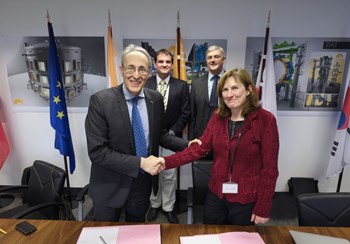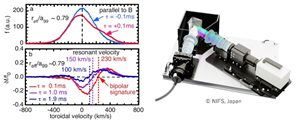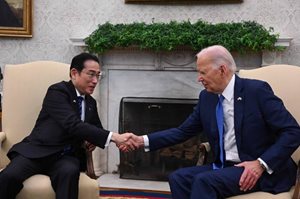
The collaboration agreement on plasma control software was signed in November by ITER Director-General Bernard Bigot and IPP Scientific Director Sibylle Günter. (In the background, ITER's Axel Winter and IPP's Gerhard Raupp.) Photo: ITER Organization/Christian Lünig
Plasma experiments at ITER will be driven by a complex real-time software infrastructure. This infrastructure will be developed with support from the fusion community in an open international collaboration, currently with partners from Europe and the US. The CODAC Section of the ITER Organization and the Max Planck Institute for Plasma Physics (IPP) in Garching, Germany, have agreed on a long-term collaboration to drive this development.
One of the major aims of the collaboration is also the deployment of the real-time infrastructure at the ASDEX Upgrade tokamak where it will be tested in routine operation. The migration of the real-time control system of ASDEX upgrade to the new infrastructure is foreseen, making it an ideal machine to develop and demonstrate control concepts for ITER using an identical software base.
Controlling the fusion plasma for ITER is a very complex task. It involves not only magnetically confining and stabilizing the plasma, but also driving the machine to achieve its performance
goal of Q=10 and a produced fusion power of 500 MW.
"In order to achieve these goals, the real-time system controlling the ITER plasma discharges will be significantly more complex than the ones used at existing fusion devices," explains Axel Winter, who is responsible for the real-time plasma control software in the ITER team. "We are already working closely with teams here at ITER and in the Domestic Agencies to ensure that the real-time control system will also be able to serve the ITER diagnostics."
The real-time control system will use data from about 100 diagnostics to calculate the necessary control signals for the plant systems which can influence the plasma discharge, for example the power supplies for the magnetic coils, fuelling or heating systems.
This allows the discharge program—with a target duration of up to 1 hour—to be tailored to the needs of the scientists and engineers. "It will require a smart system capable of not only quickly counteracting fast plasma instabilities but also adapting the discharge program in real-time to make full use of the long plasma duration. In addition, the system needs to be robust, yet flexible, so we can continue to develop it over the course of the ITER lifetime, integrating our expanding knowledge, adapting the control systems to changing conditions, and rapidly implementing new concepts," adds Gerhard Raupp from IPP who, together with Axel, will manage the IPP-ITER Organization collaboration.
The six-year agreement was recently signed by ITER Director-General Bernard Bigot and IPP Scientific Director Sibylle Günter during a visit of an IPP delegation to the ITER site.
The collaboration will be executed in three phases. After the development of the complex software infrastructure is completed in a first phase, it will be tested at the ASDEX Upgrade tokamak in Garching using a diagnostic as a test system during routine operation. Finally, the migration of ASDEX Upgrade's real-time control system to the new software infrastructure is foreseen, making ASDEX Upgrade an ideal test bed to develop and demonstrate control concepts for ITER using an identical software base.
IPP has a strong track record in the field. In 1988, the first fully digital plasma control system was implemented at ASDEX, followed in 2000 by the first plasma control system based on a modular software framework, which is also the conceptual vision for ITER. Axel concludes: "As both ASDEX Upgrade and ITER will use an identical software infrastructure, we can expect very strong synergies both for the development and testing of control schemes for ITER and for future training of ITER operators at an existing tokamak."







